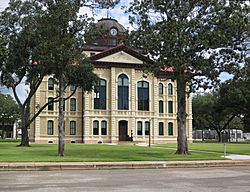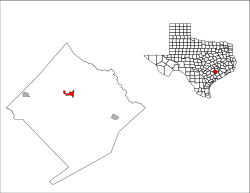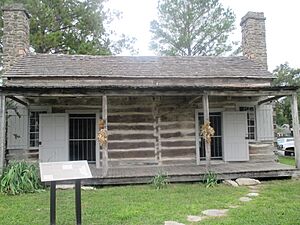Columbus, Texas facts for kids
Quick facts for kids
Columbus, Texas
|
|
|---|---|

The Colorado County Courthouse, built 1890–1891: this 2014 photo shows restoration to original color scheme made in 2013
|
|

Location of Columbus, Texas
|
|
| Country | United States |
| State | Texas |
| County | Colorado |
| Area | |
| • Total | 2.98 sq mi (7.72 km2) |
| • Land | 2.98 sq mi (7.71 km2) |
| • Water | 0.01 sq mi (0.01 km2) |
| Elevation | 203 ft (62 m) |
| Population
(2020)
|
|
| • Total | 3,699 |
| • Density | 1,224.31/sq mi (472.75/km2) |
| Time zone | UTC-6 (Central (CST)) |
| • Summer (DST) | UTC-5 (CDT) |
| ZIP code |
78934
|
| Area code(s) | 979 |
| FIPS code | 48-16168 |
| GNIS feature ID | 1333156 |
Columbus is a city in southeastern Texas, United States. It is the main city and county seat of Colorado County. In 2020, about 3,699 people lived there. The city is located right on the Colorado River.
A fun place to visit in Columbus is the Santa Claus museum. The Colorado County Courthouse is also a famous building. It is listed on the National Register of Historic Places.
Contents
History
The first American settlers arrived in the Columbus area in 1821. In 1822, the Mexican government gave land to people like Benjamin Beason and Abram Alley. They were part of Stephen F. Austin's "Old Three Hundred" settlers.
Abram Alley's log cabin from the 1830s is still in Columbus. It is now a tool museum. Benjamin Beason started a ferry across the Colorado River in 1822. This made the settlement known as Beason's Ferry. He also built a mill and a gin.
Beason's Crossing became part of Austin's San Felipe colony in 1822. The Mexican government allowed the settlers to create a town. They elected their own leaders. John J. Tumlinson Sr. was chosen as the alcalde (a type of mayor).
By 1836, over 25 families lived at Beason's Ferry Crossing. During the fight for Texas independence, Sam Houston and his soldiers camped near Beason's Crossing. After the Battle of the Alamo, Houston ordered the town to be burned. This was part of the "Runaway Scrape" to slow down the Mexican army.
Columbus was officially started in 1837 after Texas became independent. People moved back to the area and renamed Beason's Crossing "Columbus." Some think it was named after settlers from Columbus, Ohio. Others believe it was named after Christopher Columbus.
The town was planned out again in 1837. The Dewees family gave land for a new school and a courthouse. By this time, Columbus had two public houses, two stores, and several small homes.
Columbus became the main city for Colorado County. It grew into an important center for business and trade. Raising cattle was a big business in the late 1800s. Wealthy merchants and ranchers built beautiful homes.
One example is the Stafford Opera House. It was built by Robert E. Stafford. Today, it is a museum and a place for events and performances. Other historic homes that are now museums include the Dilue Rose Harris House Museum. The Tate-Senftenburg-Brandon House is also historic, but it is now privately owned.
The Colorado County Courthouse was built in 1890. It was designed by a famous architect named Eugene T. Heiner. The building has a Classical Revival and Italianate style. It is listed on the National Register of Historic Places. In 2013–2014, the courthouse was restored to its original look.
Geography
Columbus is located along Interstate 10. It is on the southwest side of the Colorado River.
The city covers about 2.98 square miles (7.72 square kilometers). Only a tiny part of this area is water.
Climate
Columbus has a humid subtropical climate. This means it has hot, humid summers. The winters are generally mild to cool.
Population
| Historical population | |||
|---|---|---|---|
| Census | Pop. | %± | |
| 1880 | 1,959 | — | |
| 1890 | 2,199 | 12.3% | |
| 1900 | 1,824 | −17.1% | |
| 1910 | 1,655 | −9.3% | |
| 1920 | 1,433 | −13.4% | |
| 1930 | 2,054 | 43.3% | |
| 1940 | 2,422 | 17.9% | |
| 1950 | 2,878 | 18.8% | |
| 1960 | 3,656 | 27.0% | |
| 1970 | 3,342 | −8.6% | |
| 1980 | 3,923 | 17.4% | |
| 1990 | 3,367 | −14.2% | |
| 2000 | 3,916 | 16.3% | |
| 2010 | 3,655 | −6.7% | |
| 2020 | 3,699 | 1.2% | |
| U.S. Decennial Census | |||
In 1890, Columbus had 2,199 people. By 1900, the population went down to 1,824. In 2020, the city's population was 3,699.
Most people in Columbus are White (51.01%). About 16.82% are Black or African American. Around 28.82% are Hispanic or Latino.
In 2020, there were 1,209 households in Columbus. There were 812 families living in the city. The average household had about 2.40 people.
Arts and culture
The Santa Claus Museum is a popular place to visit in Columbus. It started with a collection of Santa Claus items from Mary Elizabeth Hopkins.
The historic Alley Log Cabin and Tool Museum is another unique site. It dates back to the 1830s.
Education
The Columbus Independent School District serves the city. It includes:
- Columbus High School (grades 9–12)
- Columbus Junior High (grades 6–8)
- Columbus Elementary (Pre-kindergarten–grade 5)
The school mascot for Columbus is the Cardinal.
There is also Saint Anthony Catholic School in Columbus. It is a private school for students from pre-kindergarten to eighth grade. Wharton County Junior College is the community college for the area.
Highways
Major roads that go through Columbus include:
 I-10
I-10 US 90
US 90 SH 71
SH 71
Notable people
- Donna Campbell – a former resident and member of the Texas Senate.
- Tanya McQueen – an interior designer from the TV show Extreme Makeover: Home Edition.
- Doug Rau – a former Major League Baseball pitcher.
- Aaron Schobel – a former NFL defensive end for the Buffalo Bills.
- Bo Schobel – a former defensive end for the Arizona Cardinals.
- Matt Schobel – a former tight end for the Cincinnati Bengals and Philadelphia Eagles.
- Hal Smith – a former Major League catcher and third baseman.
- James Truchard – a co-founder of National Instruments.
- LaAdrian Waddle – an NFL player for the New England Patriots.
Images for kids
-
Colorado River in Beason's Park in Columbus
See also
 In Spanish: Columbus (Texas) para niños
In Spanish: Columbus (Texas) para niños







